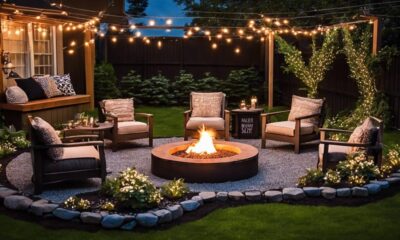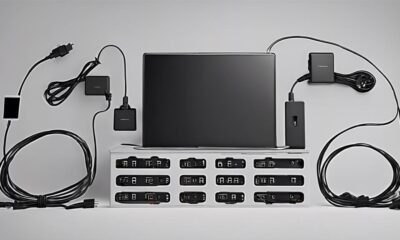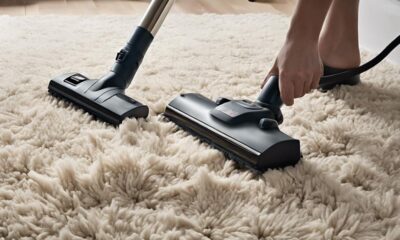Decor
Learn to Create Simple No-Sew Shabby Chic Pillow Covers
Sparkle up your space with a stunning no-sew shabby chic pillow cover, and discover the secrets to creating a professional-looking masterpiece.
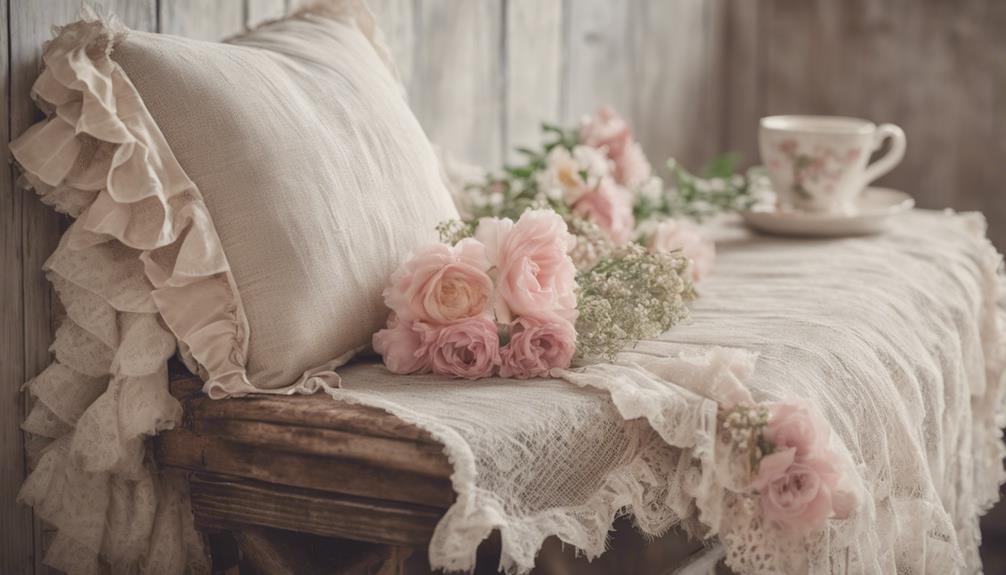
We're excited to create simple no-sew shabby chic pillow covers that add a touch of elegance to any room. We'll start by gathering materials like fabric, heat bonding tape, scissors, and an iron. Next, we'll cut and iron our fabric to size, ensuring a smooth, professional finish. Applying heat bonding tape will allow us to assemble our pillow cover with precision. With some additional tips and tricks, like using fabric clips and adding personalized designs, we'll achieve a beautiful, professional-looking pillow cover. As we continue, we'll discover more techniques to perfect our no-sew shabby chic masterpiece.
Key Takeaways
• Use half to one yard of fabric for the decorative outer layer, and cut it to size with a seam allowance for a professional finish.
• Apply heat bonding tape to assemble the pillow cover with precision and a strong hold, ensuring a clean and smooth finish.
• Iron the fabric before assembling the cover to remove wrinkles and achieve a smooth shape, and use fabric clips or pins to secure the fabric.
• Add personalized designs or embellishments to create a unique and customized shabby chic look, and experiment with different design techniques.
• Leave one side open for easy pillow form insertion and removal, and trim excess fabric for clean edges and a professional finish.
Gathering Essential Materials
We start by gathering the essential materials needed to create our no-sew shabby chic pillow covers. I'm going to walk you through this process for the first time, and I'm excited to share it with you!
To begin, we'll need a few basic supplies. First, we'll need a pillow form that measures 12×16 inches. This will serve as the base for our cover. Next, we'll need some fabric – about half to one yard should do the trick. We'll use this to create the decorative outer layer of our pillow cover.
Additionally, we'll need some heat bonding tape, which is a game-changer for no-sew projects. This tape will help us create a strong bond between our fabric pieces without sewing. Finally, we'll need some scissors to cut our fabric to size and an iron to activate the heat bonding tape.
With these materials in hand, we'll be ready to start creating our beautiful no-sew shabby chic pillow covers.
Cutting Fabric to Size

Now that we've our materials ready, let's get started with cutting our fabric to size.
To guarantee a perfect fit, we'll need to measure our pillow form accurately and cut our fabric accordingly.
In this section, we'll discuss some essential tips on measuring our fabric, determining the right pillow size, and cutting our fabric with precision.
Fabric Measurement Tips
When measuring fabric for a 12×16 inch pillow cover, we add 2-2.5 inches to each side to account for seam allowance. This guarantees that our pillow cover fits snugly around the pillow form.
To achieve a professional-looking cover, it's essential to cut our fabric accurately. We'll need two pieces of fabric, identical in size, to make sure of a smooth and even fit.
Before cutting, we iron our fabric to remove any wrinkles and creases. This helps us achieve a smooth and neat finish on our pillow cover.
Once we've cut our fabric to size, we'll use heat bonding tape to attach the two pieces together. This eliminates the need for sewing, making it easy to create a no-sew pillow cover.
Determining Pillow Size
To guarantee a perfect fit, we'll measure our pillow form carefully and add 2-2.5 inches to each side to account for seam allowance before cutting our fabric. This assures our pillow cover fits snugly and has a professional finish.
When measuring, we'll want to place the pillow form in the center of the fabric to confirm proper sizing. Then, we'll cut two identical pieces of fabric for the front and back of the pillow cover.
Here's a quick reference guide to help us determine the fabric size we need:
| Pillow Form Size | Fabric Size |
|---|---|
| 12' x 12' | 14' x 14' |
| 14' x 14' | 16' x 16' |
| 16' x 16' | 18' x 18' |
| 18' x 18' | 20' x 20' |
Cutting Fabric Accurately
We measure and cut our fabric pieces to be 13×17 inches for a 12×16 inch pillow form, allowing for a 1-inch seam allowance on each side. This guarantees a snug fit and prevents the fabric from stretching or sagging.
When cutting, we use fabric scissors to guarantee clean cuts and prevent fraying, especially if we're working with delicate or fringed fabrics. Before making the cut, we always double-check our measurements to avoid errors and achieve a perfect fit.
If we're unsure, we start by cutting a larger piece of fabric and trimming it down gradually to achieve the perfect size. For larger quantities of fabric, we consider using a rotary cutter and a cutting mat for more precise and efficient cutting.
Ironing Fabric for Shape
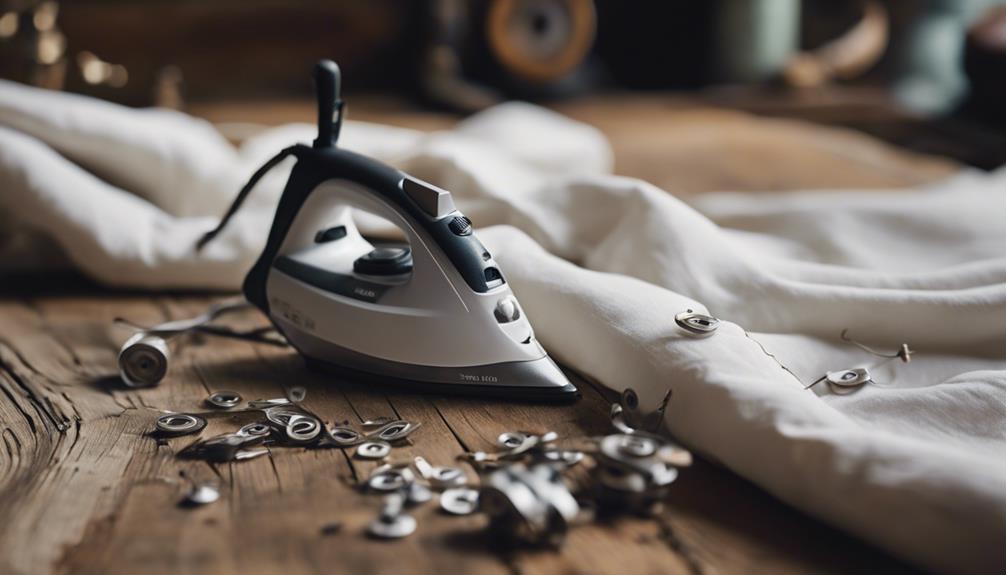
Ironing out wrinkles and creases in our fabric is essential before moving forward, as it sets the stage for a smooth, reliable bond with the heat bonding tape. By removing wrinkles and creases, we guarantee a flat surface for bonding, which is vital for a strong and secure hold. This step is often overlooked, but it makes a significant difference in the final result.
Here's why ironing is pivotal for our pillow cover:
| Benefits of Ironing | Why it Matters |
|---|---|
| Removes wrinkles and creases | Ensures a smooth surface for bonding |
| Sets fabric dimensions and shape | Gives our pillow cover a professional look |
| Prepares fabric for bonding | Creates a strong and secure hold |
Applying Heat Bonding Tape
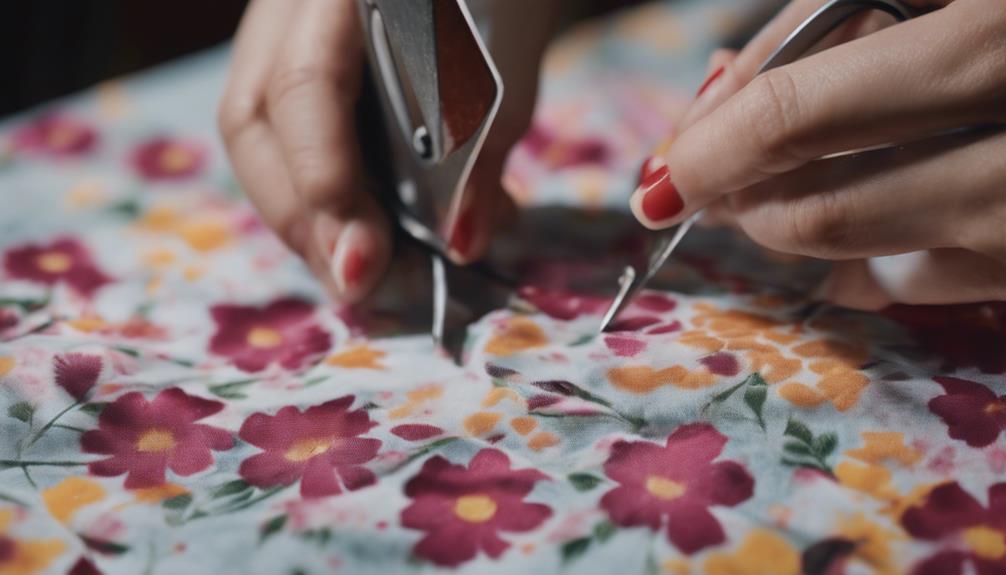
Trimming the heat bonding tape to fit the edges of our fabric pieces, we guarantee a seamless application that yields a strong and secure attachment. This is important in making sure our no-sew pillow cover looks professional and polished.
By using heat bonding tape, we can skip the sewing machine and still achieve a clean, seamless finish. The tape is incredibly easy to use – simply cut it to size, place it between the fabric pieces, and apply heat using an iron. The heat activates the tape, creating a strong bond between the fabrics. It's vital to press the tape evenly to ensure a secure attachment.
With heat bonding tape, we can create beautiful, shabby chic pillow covers without any sewing skills. This versatile tool is perfect for various fabric projects, providing a reliable hold for our DIY creations.
Assembling the Pillow Cover

Now that we've applied the heat bonding tape, it's time to assemble our pillow cover.
We'll start by flipping the cover right-side out and inserting the pillow form, making sure it fits snugly.
Next, we'll focus on the key points of assembling the pillow cover, including aligning our pillow cover pieces, measuring our fabric correctly, and pinning and placing the fabric to guarantee a beautiful, shabby chic finish.
Pillow Cover Pieces
We're ready to bring our pillow cover together by attaching the two fabric pieces, creating a beautiful, shabby chic design. To do this, we'll use heat bonding tape to secure the edges.
Here's how we'll assemble our pillow cover:
- Lay one fabric piece face up and trim heat bonding tape to fit one edge.
- Press the tape with an iron for 2 seconds per section to create a bond.
- Repeat the process for three sides, leaving one side partially open for inserting the pillow form.
- Once the bonding tape is applied, peel off the paper liner and bond the second fabric piece to create the cover.
- Ensure consistent heating with the iron to secure a tight bond, and trim excess fabric for clean edges before finalizing the pillow cover.
Measuring Fabric Correctly
To guarantee a snug and professional-looking fit, we measure our fabric carefully, allowing 2-2.5 inches of extra fabric around the pillow form for seam allowance. This extra room will ensure our seams are secure and our pillow cover looks polished.
We take the measurements of our pillow form and add the necessary extra fabric to each dimension. Then, we cut two pieces of fabric according to these measurements, making sure to leave room for the seams. It's important to get these measurements right, as it impacts the overall fit and appearance of our pillow cover.
Taking the time to measure and cut our fabric accurately will result in a beautiful, custom-made pillow cover that fits our pillow form perfectly. With precise measurements, we can avoid common mistakes and achieve a professional-looking finish. By following these simple steps, we can create a stunning shabby chic pillow cover that adds a touch of elegance to any room.
Pin and Place Fabric
With our precisely cut fabric pieces in hand, we pin the two pieces together, carefully aligning the edges and corners to guarantee a seamless finish. This step is vital in ensuring our no-sew shabby chic pillow cover looks professional and durable.
As we pin, we make sure the fabric is smooth and taut, preventing any wrinkles or puckering in the final product.
Here are some key takeaways to keep in mind as we pin and place our fabric:
- Ensure the fabric is smooth and taut to prevent any wrinkles or puckering in the final pillow cover.
- Use fabric clips or pins to secure the fabric in place before bonding with the heat bonding tape.
- Double-check the alignment and fit of the fabric pieces before permanently bonding them together.
- Take your time with this step to achieve a professional-looking and durable no-sew shabby chic pillow cover.
- Don't rush – precision is key in this step to ensure a flawless finish.
Adding Personalized Designs
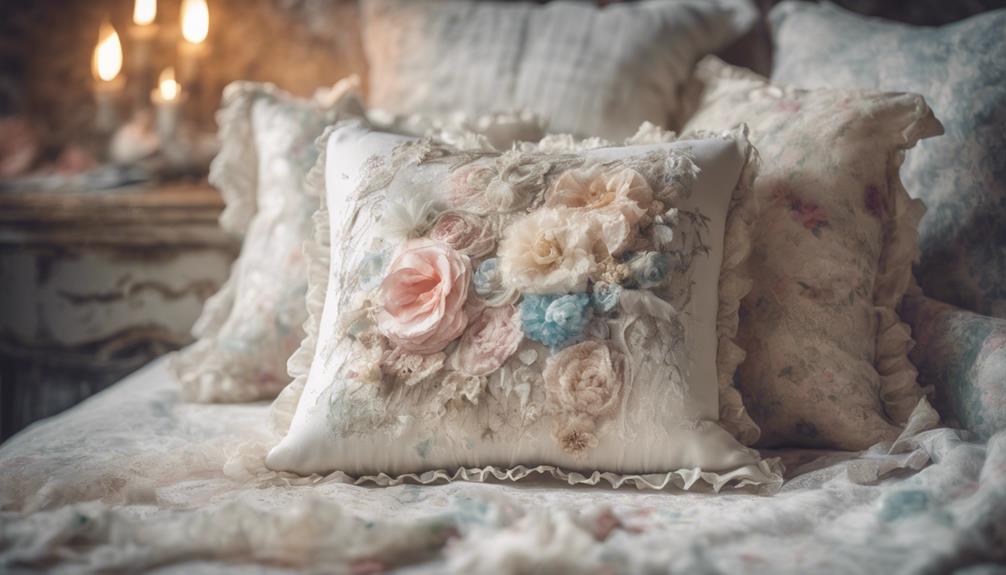
As we add the finishing touches to our shabby chic pillow covers, let's explore the various ways to incorporate personalized designs that reflect our unique style. We can use fabric paint or markers to add customized designs that make our pillow covers truly one-of-a-kind.
For more precise designs, we can use stencils to create intricate patterns and shapes. Alternatively, we can use a fabric pen to freehand our own designs or write personalized messages on the fabric.
We can also experiment with different techniques like stamping or block printing to create unique designs on our pillow covers. Adding embellishments like buttons, lace, or appliques can also add a personal touch to our shabby chic pillow covers.
Stuffing the Pillow Form
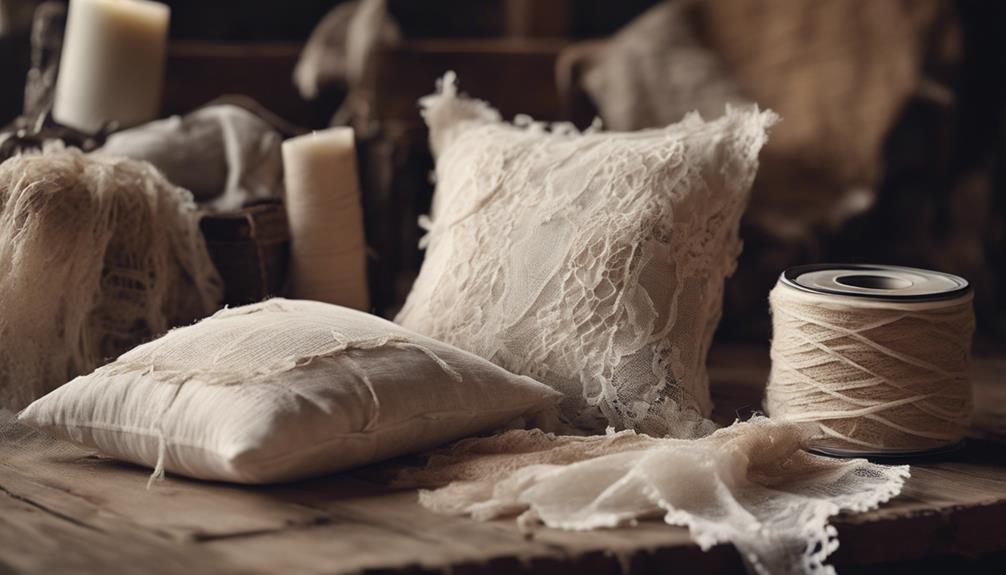
We're ready to bring our shabby chic pillow covers to life by slipping the pillow form into its new fabric home. This is the moment we've been waiting for – the transformation from a flat piece of fabric to a plush, inviting pillow.
As we stuff the pillow form, we'll want to make sure it fits snugly inside the cover. Here are some key tips to keep in mind:
- Gently insert the pillow form into the fabric cover, making certain it fits snugly.
- Smooth out any wrinkles or uneven areas in the fabric as you stuff the pillow form.
- Confirm the corners of the pillow form are fully filled in to create a plump and even look.
- Adjust the positioning of the pillow form inside the cover to achieve the desired shape and fullness.
- Make sure the pillow form is evenly distributed and centered within the cover for a professional finish.
Securing the Open Edge
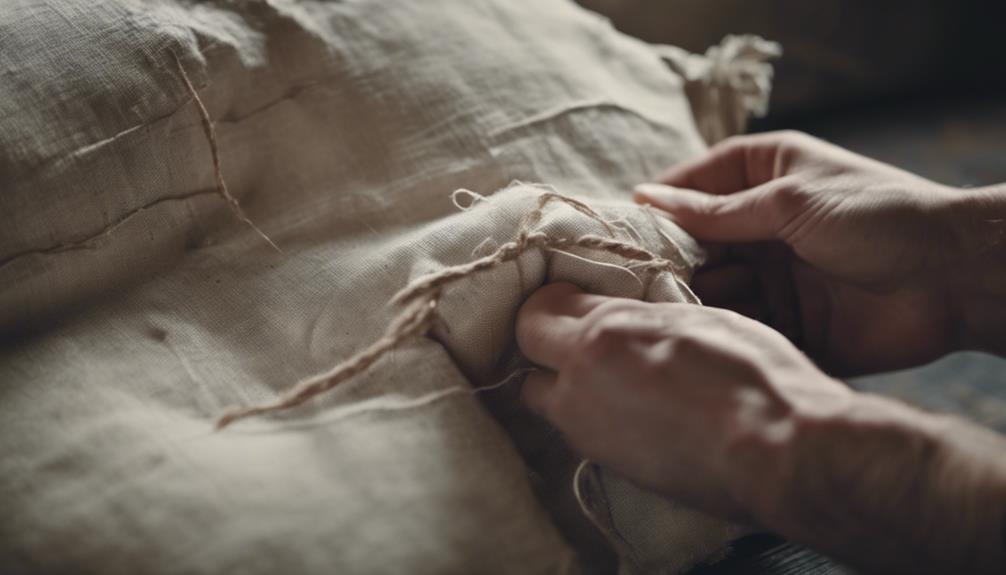
We secure the open edge of our pillow cover by cutting a piece of bonding tape to fit the opening, ensuring a clean finish.
To achieve this, we fold in the seam of the fabric pieces to create a clean edge.
Next, we use an iron to bond the opening edge securely with the bonding tape. This step is essential to prevent any fraying or unraveling of the fabric.
For an extra-strong hold, we can also consider using fabric glue to reinforce the bond.
By taking these steps, we can confidently secure the open edge of our pillow cover, giving it a professional finish.
With the edge secure, we can now focus on adding any final touches to our pillow cover, such as stenciled designs or embellishments, to give it a unique and personalized look.
Finishing Touches and Tips
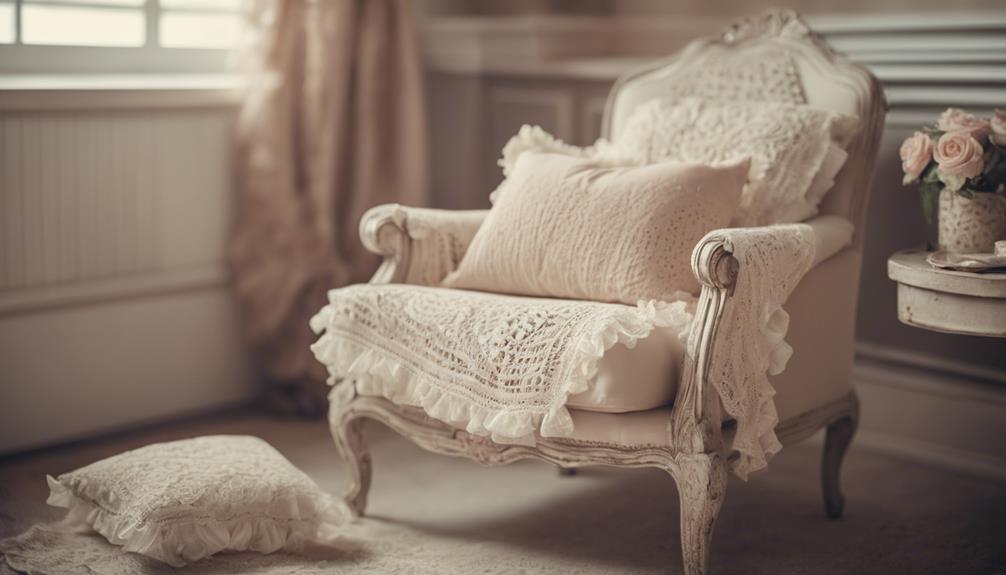
With our pillow cover's open edge securely bonded, we can finally add the finishing touches that will give our shabby chic creation a truly unique and personalized look. This is where we get to express our creativity and add those special details that make our pillow cover truly one-of-a-kind.
Here are some tips to keep in mind as we add those finishing touches:
- Consider using fabric glue for a stronger hold if the bonding tape doesn't provide enough security.
- Customize your pillow covers with stenciled designs or embellishments for a personal and unique touch.
- Confirm the fabric pieces are evenly heated with the iron to create a tight bond for a professional finish.
- Trim any excess fabric for clean edges and a polished look to your shabby chic pillow covers.
- Remember to leave one side open for bonding to easily insert and remove the pillow form for washing or changing covers.
Frequently Asked Questions
How to Make a Pillow Cover Without Stitching?
We're excited to share a solution to the problem of making a pillow cover without stitching!
We've found that heat bonding tape is a game-changer. Simply cut fabric pieces with a 2-2.5 inch seam allowance, attach them together with bonding tape, leaving one side open for the pillow form.
Then, bond the open side, trim excess fabric, and add decorative touches. Voila! A beautiful no-sew pillow cover that's easy to create.
How to Make a No-Sew Pillow Sham?
We're making a no-sew pillow sham!
We start by cutting two fabric pieces to fit our pillow form.
Next, we use heat bonding tape to attach the fabric pieces together, leaving one side open for the pillow form.
Once the pillow's in, we bond the final edge.
Voilà! Our no-sew pillow sham is done.
We can even add stenciled designs or embellishments for a personalized touch.
How to Make a Pillowcase Without a Sewing Machine?
We understand what you're thinking: 'No sewing machine? No problem!'
We've got a solution for you. To make a pillowcase without a sewing machine, we use heat bonding tape to create a seamless finish.
We cut two fabric pieces, leaving a 2-2.5 inch seam allowance, attach the tape to three sides, and iron to bond.
It's that simple!
How to Make Throw Pillows for Beginners?
We're excited to explore the world of throw pillows! As beginners, we'll start with the basics.
To make throw pillows, we'll need a few simple materials: pillow forms, fabric, and a few basic tools.
We'll choose a fabric that fits our style, measure and cut it to size, and then use heat bonding tape to secure the pieces together.
With a few easy steps, we'll have beautiful throw pillows to add a pop of color and comfort to any room.
Conclusion
As we step back to admire our handiwork, the soft, rumpled fabric seems to whisper promises of cozy nights and lazy mornings. Our no-sew shabby chic pillow cover, with its imperfect edges and gentle creases, has transformed a humble pillow into a haven of comfort.
With every stitch-free seam, we've woven a tale of rustic charm, beckoning all who enter to linger, relax, and let the world slow down.
- About the Author
- Latest Posts
Introducing Ron, the home decor aficionado at ByRetreat, whose passion for creating beautiful and inviting spaces is at the heart of his work. With his deep knowledge of home decor and his innate sense of style, Ron brings a wealth of expertise and a keen eye for detail to the ByRetreat team.
Ron’s love for home decor goes beyond aesthetics; he understands that our surroundings play a significant role in our overall well-being and productivity. With this in mind, Ron is dedicated to transforming remote workspaces into havens of comfort, functionality, and beauty.
Southeast Asia Decor
Indonesian Textiles Shaping Contemporary Interior Design
Navigating the vibrant world of Indonesian textiles reveals how batik and ikat can transform your interior design—discover the secrets to blending tradition and modernity.

Indonesian textiles, like batik and ikat, are shaping contemporary interior design by merging traditional craftsmanship with modern flair. These vibrant fabrics bring a unique cultural narrative to your space, enhancing aesthetics while promoting sustainability. You can use batik-covered upholstery, ikat curtains, or custom throw pillows to add character and warmth to any room. As you incorporate these textiles, you'll experience a blend of heritage and style that's versatile enough for both casual and formal settings. Want to discover how to effectively integrate these textiles into your decor? There's so much more to uncover!
Key Takeaways
- Indonesian textiles like batik and ikat blend traditional artistry with modern aesthetics, enhancing contemporary interior design with cultural richness.
- Sustainable fabric technologies in Indonesian textiles promote durability, making them suitable for diverse applications in modern interior settings.
- The versatility of batik and ikat allows them to complement various decor styles, from casual to formal, in both residential and commercial spaces.
- Creative uses of Indonesian textiles include upholstery, curtains, and wall art, adding unique visual narratives and textures to interior designs.
- Preservation efforts for Indonesian textiles ensure the continuation of traditional weaving techniques and support local artisans, enriching the design landscape.
Cultural Heritage of Indonesian Textiles
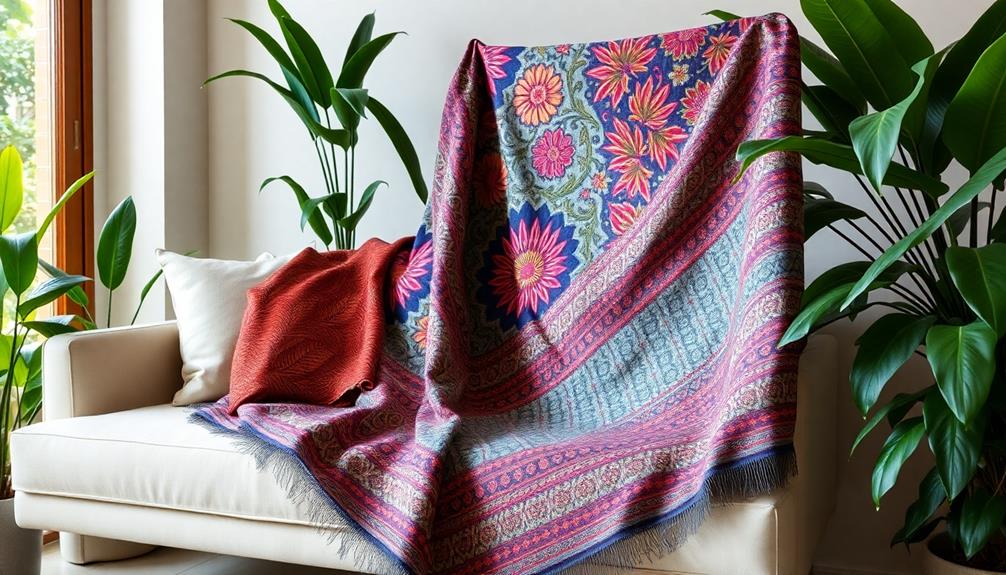
Have you ever wondered how Indonesian textiles reflect the country's rich cultural heritage? One of the most notable examples is Indonesian batik, which originates from Central Java. This exquisite art form utilizes a wax-resist dyeing technique to create intricate patterns that tell stories of tradition and identity. Each design carries meaning, connecting you to the diverse cultures across Indonesia.
Additionally, the craftsmanship involved in producing these textiles encourages appreciation for traditional artistry, similar to the unique artistic expressions found in Indonesian decor masks.
Batik's significance was recognized by UNESCO in 2009, earning its status as a Masterpiece of Oral and Intangible Heritage. This acknowledgment highlights how deeply intertwined batik is with Indonesian cultural heritage, showcasing its relevance even in modern society.
The artistry doesn't stop at batik; other textiles like Ikat and Tapis contribute their own narratives. While Ikat features pre-dyed threads, Tapis is adorned with gold-wrapped threads, symbolizing social status in Lampung. These textiles preserve rich narratives and showcase the artistry of various regions.
To guarantee the survival of these essential practices, workshops and training programs educate new generations about these traditional crafts.
Traditional Weaving Techniques
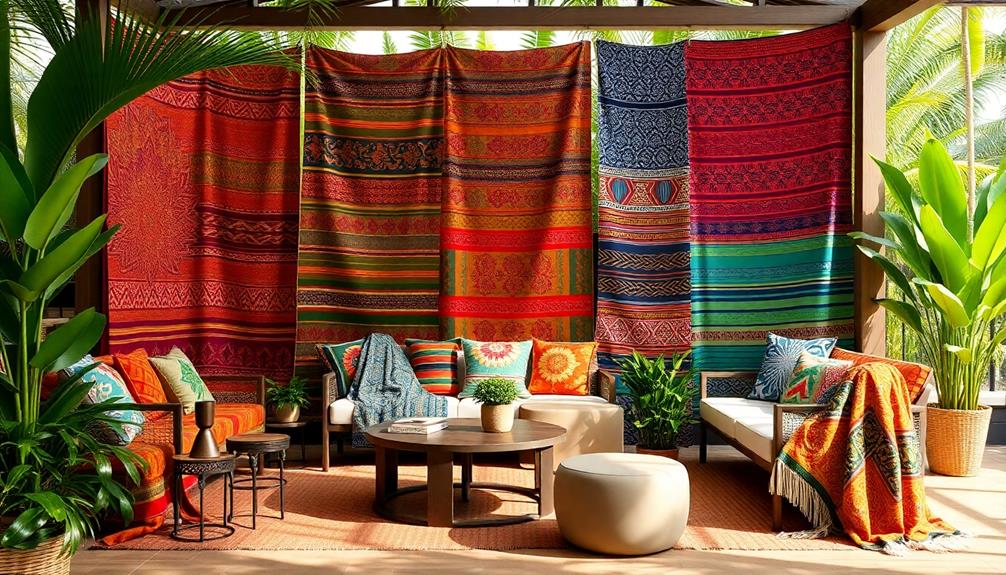
Building on the rich narratives woven into Indonesian textiles, traditional weaving techniques like Ikat and Batik showcase the intricate craftsmanship that defines this art form. A visual analysis reveals how these methods create stunning patterns that tell stories steeped in cultural significance.
| Technique | Description | Characteristics |
|---|---|---|
| Ikat | Uses pre-dyed threads to form patterns | Blurred edges, vibrant colors |
| Batik | Involves wax-resist dyeing | Unique motifs, intricate designs |
| Batik Tulis | Hand-drawn process, time-consuming | Artisan skill, personal touch |
| Batik Cap | Stamped designs for quicker production | Reproducible patterns, mass appeal |
| Regional Styles | Unique patterns per region | Reflects local culture and identity |
Ikat is known for its blurred edges, showcasing the artisan's skill in pattern design. Meanwhile, Batik, originating from Java, employs a tjanting tool to apply hot beeswax, resulting in intricate motifs. The two types of Batik—Tulis and Cap—exhibit varying levels of detail and time commitment. Each region's distinct weaving style signifies local culture, making the preservation of these techniques essential for maintaining Indonesia's cultural heritage.
Economic Contributions of Textiles
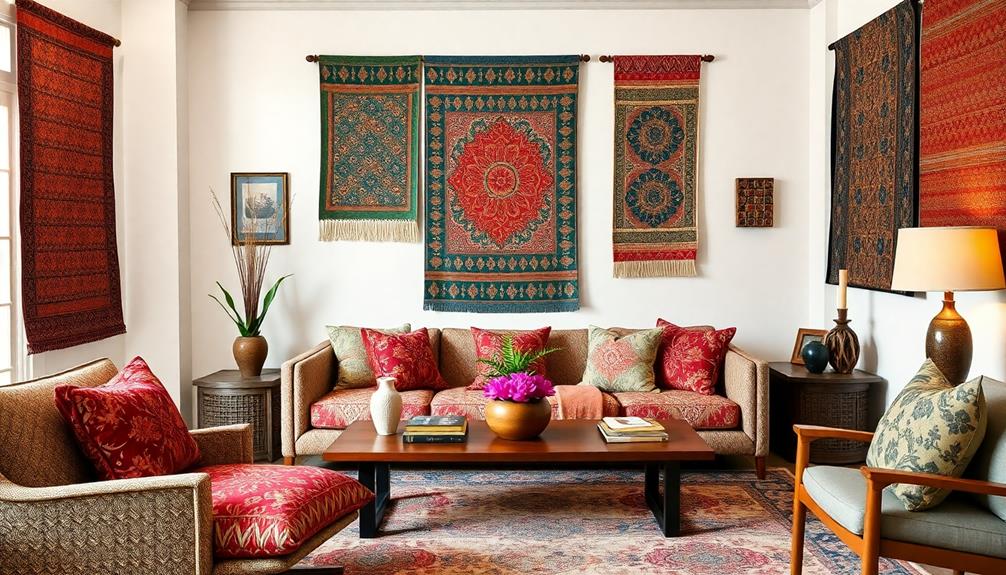
The Indonesian textile industry plays an essential role in the country's economy, generating billions in revenue and providing jobs for millions of artisans and workers. As you investigate the vibrant world of Indonesian textiles, you'll notice that local cooperatives and artisan groups thrive through the production of traditional fabrics. This not only fosters sustainable livelihoods but also empowers communities through skill development and fair trade practices.
Additionally, textiles such as Indonesian decorative pillows enhance living spaces and contribute to the economic landscape.
The export of textiles, especially iconic batik and ikat, greatly boosts international trade, with major markets in Europe, the United States, and Australia. You'll find that government initiatives aimed at promoting the sector, such as financial support and marketing assistance, have increased visibility and demand for Indonesian textiles globally.
Additionally, the integration of sustainable practices in textile production enhances economic viability and attracts eco-conscious consumers. This shift drives growth in eco-friendly tourism and ethical fashion markets, creating a unique niche for Indonesian textiles.
As you explore further into the economic contributions of textiles, you'll see how they shape not only the livelihoods of many but also the global perception of Indonesian craftsmanship and culture.
Modern Design Innovations

Modern design innovations are blending traditional Indonesian textiles with contemporary aesthetics in exciting ways.
By incorporating elements of Balinese design characteristics, these textiles enhance the overall ambiance of a space while promoting sustainability.
Sustainable fabric technologies are enhancing the durability of these textiles, making them perfect for today's interiors.
Plus, the collaboration between artisans and designers is breathing new life into craftsmanship, appealing to those who value ethical and unique design.
Traditional Meets Contemporary Aesthetics
Indonesian textiles' rich heritage is finding new life in contemporary interior design, where traditional elements like batik and ikat blend seamlessly with modern aesthetics.
You'll notice how contemporary designers are increasingly incorporating these vibrant fabrics into their projects, creating a striking fusion of cultural heritage and innovation. Innovations in fabric technology have enhanced the durability and appeal of these textiles, allowing their use in various applications, from upholstery to wall coverings.
This integration mirrors the principles of traditional Indonesian style home decor, which emphasizes harmony with nature and the use of natural materials.
As you explore spaces adorned with Indonesian fabrics, the intricate patterns often serve as focal points, adding depth and character while promoting cultural storytelling.
Collaborations between local artisans and modern designers foster creativity, ensuring that traditional weaving practices are preserved while adapting to contemporary trends.
Moreover, the global shift towards ethical fashion and sustainable practices has sparked a growing interest in these textiles.
This trend encourages their use in eco-friendly interior design projects, making your choices both stylish and responsible.
Sustainable Fabric Innovations
How can sustainable fabric innovations transform your interior spaces? By incorporating Indonesian textiles made from eco-friendly materials and natural fibers like organic cotton and bamboo, you can create beautiful, responsible interiors that reflect your values.
These sustainable fabrics not only reduce environmental impact compared to synthetic options but also enhance the durability and aesthetic appeal of your décor. Additionally, integrating traditional art pieces such as Indonesian decor masks can bring a unique cultural touch to your design while celebrating local craftsmanship.
Contemporary designers are increasingly collaborating with local artisans, merging traditional weaving techniques with modern design elements. This fusion results in unique fabric collections that celebrate cultural heritage while promoting environmental stewardship.
As global interest in ethical fashion grows, Indonesian textiles are making a significant comeback in interior design, offering you stylish choices that align with contemporary trends focused on sustainability.
You'll find that the vibrant colors derived from eco-friendly dye processes further elevate your space, creating an inviting atmosphere. By choosing sustainable fabric innovations, you're not just decorating your home; you're also contributing to a more sustainable future.
Artisanal Craftsmanship in Design
Embracing artisanal craftsmanship in modern design opens up a world of possibilities for your interior spaces. By blending traditional Indonesian textiles like batik and ikat with contemporary aesthetics, you create a rich narrative that enhances your environment.
Incorporating elements like Indonesian decor masks can further enrich the visual storytelling in your home. Collaborations between local artisans and designers spark creativity, transforming age-old patterns into fresh designs that resonate with your style.
Consider these four enthralling elements to incorporate into your home:
- Vibrant Batik Cushions: Add a pop of color and a touch of heritage to your living room.
- Ikat Upholstery: Use these unique fabrics to reupholster chairs, blending comfort with cultural significance.
- Handwoven Wall Hangings: Infuse warmth and texture, making a bold statement on your walls.
- Sustainable Decorative Accents: Choose ethically sourced textiles that highlight craftsmanship and tell a story.
These innovations in fabric technology not only enhance durability but also guarantee that each piece you choose celebrates the artistry and tradition behind it.
Importance of Preservation Efforts
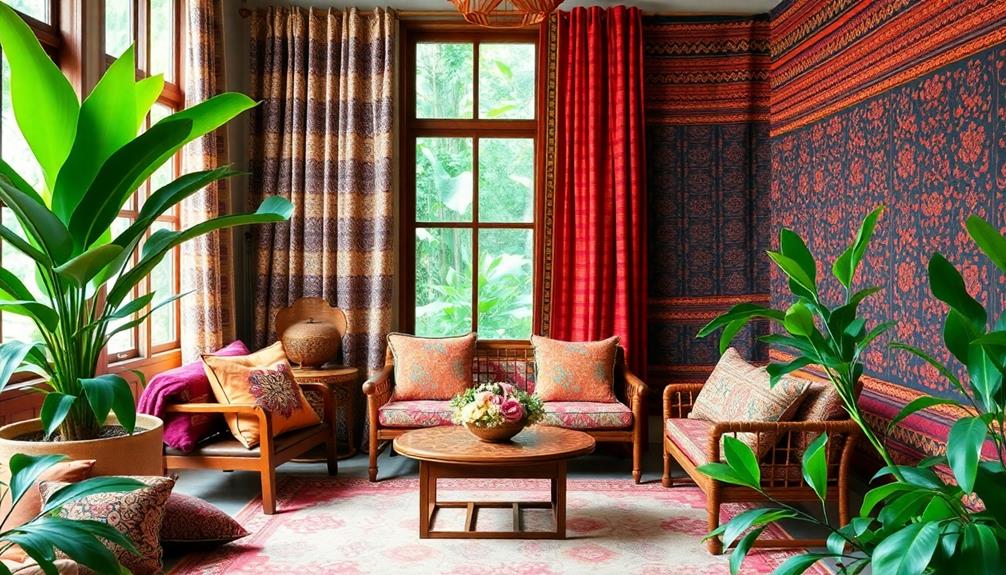
Preserving Indonesian textiles is essential for safeguarding cultural heritage and ensuring that traditional weaving techniques endure.
The vibrant patterns and designs often reflect the unique architectural styles seen in traditional Indonesian housing, emphasizing the connection between textiles and cultural identity.
You'll find that artisan training programs play a key role in passing this knowledge to future generations, keeping these important skills alive.
Cultural Heritage Conservation
Cultural heritage conservation plays an essential role in safeguarding the rich textile traditions of Indonesia, such as Batik and Ikat. By preserving these techniques, you'll help maintain the cultural identity of diverse communities spread across the archipelago.
This effort goes beyond just keeping traditions alive; it fosters a deeper understanding of heritage and craftsmanship. Additionally, the integration of traditional textiles in contemporary interior design can be seen in spaces created by experts like Mahallati Interiors, who emphasize a blend of modern luxury with cultural elements.
Here are four key aspects of cultural heritage conservation that you can support:
- Workshops and Training: Local communities engage in hands-on workshops, passing down traditional weaving techniques to younger generations.
- Documentation: Recording weaving methods and patterns guarantees that invaluable cultural knowledge isn't lost and can be appreciated by future generations.
- Support for Artisans: Government initiatives and cooperatives provide vital support, allowing artisans to sustain their crafts while preserving their cultural practices.
- Global Interest: With the rise of ethical fashion, there's renewed focus on traditional textiles, which boosts eco-friendly tourism and cultural heritage conservation.
Artisan Training Programs
Artisan training programs are essential for keeping traditional Indonesian weaving techniques, like Batik and Ikat, alive and thriving. These programs provide hands-on workshops that equip local artisans with the skills they need to create high-quality textiles while preserving the authenticity of traditional designs.
Additionally, these initiatives often draw upon the rich cultural heritage reflected in traditional housing designs, showcasing the importance of community-oriented craftsmanship. By engaging in these initiatives, you contribute to the economic stability of communities, as skilled artisans can produce goods that meet both local and international market demands.
Moreover, these training efforts deepen your understanding of the cultural significance and storytelling woven into Indonesian textiles. This fosters a stronger sense of community identity and heritage, reinforcing the connection between the artisans and their craft.
Organizations dedicated to textile preservation often work closely with artisans to document techniques and patterns, creating valuable resources for educational and cultural purposes.
As you support artisan training programs, you're not just helping to maintain age-old traditions; you're also investing in the future of these vibrant communities. This commitment to preservation guarantees that the beauty and richness of Indonesian textiles continue to inspire contemporary interior design for generations to come.
Tropical Decor Inspirations

Tropical decor inspirations often burst with vibrancy and life, thanks in large part to the rich heritage of Indonesian textiles. The intricate patterns and vivid colors of batik and ikat fabrics can transform any space into a lively sanctuary.
By incorporating these textiles, you create a stunning visual narrative that reflects both culture and modern design. Additionally, integrating elements from tropical villa plans can enhance the serene atmosphere by emphasizing open spaces and natural light.
To bring this tropical feel into your home, consider these ideas:
- Cushions: Use batik or ikat fabrics for throw pillows to add color and texture to your seating areas.
- Drapes: Hang lightweight, patterned curtains that dance with the breeze, letting in natural light while still providing privacy.
- Rattan Accents: Pair textiles with natural materials like rattan furniture for an organic touch that complements the vibrancy of the fabrics.
- Wall Art: Frame sections of traditional textiles as wall art, creating unique focal points that tell a story.
These elements blend comfort and style, allowing you to embrace the essence of tropical living while supporting sustainable practices and local artisans.
Batik and Its Significance
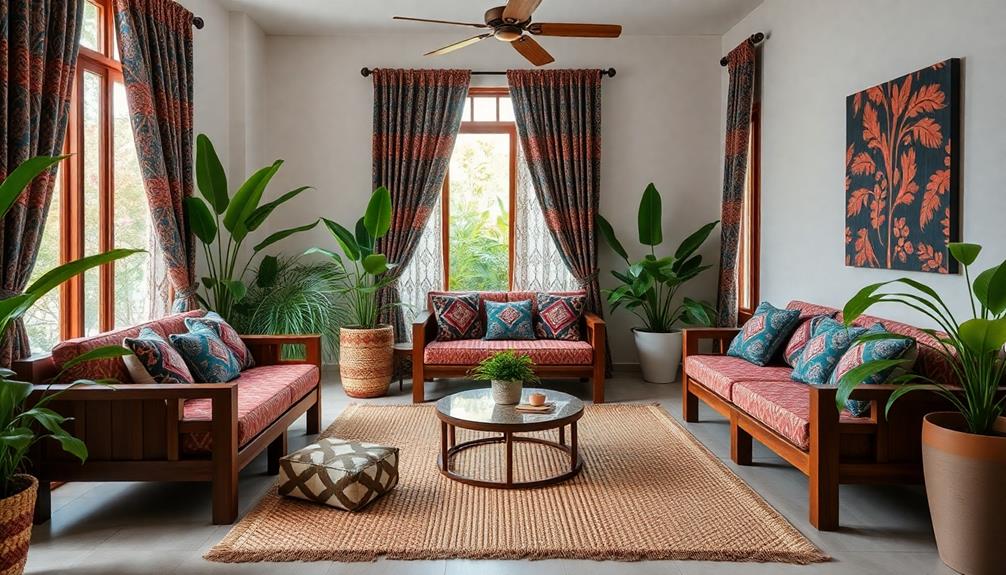
Indonesian textiles, particularly batik, offer a profound connection to the country's rich heritage. This traditional art form employs an intricate wax-resist dyeing technique, where artisans apply hot wax to fabric, creating stunning patterns before dyeing. Recognized by UNESCO in 2009 as a Masterpiece of Oral and Intangible Heritage, batik not only showcases Indonesia's cultural richness but also highlights artisanal craftsmanship.
Batik comes in two primary techniques:
| Technique | Description |
|---|---|
| Batik Tulis | Handcrafted, takes months to create |
| Batik Cap | Uses copper stamps, takes 2-3 days |
Each batik piece features unique motifs, such as Kawung and Parang, which symbolize significant cultural meanings, representing human life and continuity. These designs often draw inspiration from regional influences, making each piece distinct.
In modern Indonesia, batik plays an essential role, influencing everything from clothing to furnishings and accessories. By embracing batik, you not only enrich your interior spaces but also support local artisans and contribute to the preservation of this exquisite craftsmanship.
Integrating Indonesian Textiles in Interiors

When it comes to enhancing interior spaces, incorporating textiles like batik and ikat can make a striking difference. These traditional Indonesian fabrics bring unique patterns and rich cultural narratives that elevate your home's aesthetic.
You can easily integrate these textiles into various design styles, whether you lean towards bohemian vibrancy or minimalist elegance.
Here are some creative ways to use batik and ikat in your interiors:
- Upholstery: Cover your chairs or sofas with vibrant batik to create a focal point in the room.
- Curtains: Use ikat fabric for window treatments to add texture and visual interest to your space.
- Throw Pillows: Mix and match batik and ikat pillows on your couch for a cozy, eclectic feel.
- Wall Art: Frame pieces of batik or ikat fabric as wall art, showcasing their beauty and craftsmanship.
Frequently Asked Questions
What Are the Best Types of Indonesian Textiles for Upholstery?
When you think of upholstery, imagine vibrant Batik patterns dancing across your furniture. Textiles like Ikat and Songket also weave rich stories into your space, giving your home warmth and character you won't want to miss.
How Do I Care for Indonesian Textile Fabrics?
To care for Indonesian textile fabrics, you should gently hand wash them in cold water with mild detergent. Avoid direct sunlight when drying, and store them in a cool, dry place to maintain their vibrant colors.
Where Can I Purchase Authentic Indonesian Textiles?
Like finding a hidden treasure, you can purchase authentic Indonesian textiles online through specialized retailers, local markets, or cultural fairs. Don't forget to check artisan cooperatives for unique pieces that tell a story. Happy hunting!
Can Indonesian Textiles Be Used in Outdoor Decor?
Absolutely, you can use Indonesian textiles in outdoor decor! They add vibrant colors and unique patterns to your space. Just make certain they're treated for weather resistance to maintain their beauty and longevity in outdoor settings.
What Color Palettes Complement Indonesian Textile Designs?
To complement Indonesian textile designs, consider earthy tones like terracotta, deep greens, and warm neutrals. These colors enhance the vibrant patterns, creating a harmonious balance that brings out the beauty of the textiles in any space.
Conclusion
Incorporating Indonesian textiles into your home isn't just about aesthetics; it's a celebration of rich cultural heritage. Imagine draping vibrant batik fabrics over your modern furniture, creating a striking contrast that's both timeless and trendy. By embracing these unique designs, you're not only enhancing your space but also supporting traditional artisans and their craft. So, go ahead and let the colors and patterns transport you to a bustling market in Bali, enriching your interior with stories of the past.
- About the Author
- Latest Posts
Introducing Ron, the home decor aficionado at ByRetreat, whose passion for creating beautiful and inviting spaces is at the heart of his work. With his deep knowledge of home decor and his innate sense of style, Ron brings a wealth of expertise and a keen eye for detail to the ByRetreat team.
Ron’s love for home decor goes beyond aesthetics; he understands that our surroundings play a significant role in our overall well-being and productivity. With this in mind, Ron is dedicated to transforming remote workspaces into havens of comfort, functionality, and beauty.
Southeast Asia Decor
Indonesian Textiles: Weaving Modern Interior Magic
Not only do Indonesian textiles add vibrant color to your home, but they also weave rich cultural stories into your modern decor—discover their magic today!

Indonesian textiles can work magic in your modern interior, infusing it with vibrant colors and deep cultural narratives. Pieces like Batik and Pua are not just beautiful; they carry rich stories and traditional craftsmanship that connect you to Indonesia's heritage. When you incorporate these textiles into your home—think pillows, curtains, and wall hangings—you add both style and a sense of history. Plus, many textiles are crafted with eco-friendly practices that support local artisans. This combination of aesthetic appeal and cultural significance makes Indonesian textiles a stunning choice for any space. Find out how to elevate your interiors even more!
Key Takeaways
- Indonesian textiles, like Batik, add vibrant colors and intricate patterns, enhancing the aesthetic appeal of modern interiors.
- Traditional fabrics can be used creatively in various decor elements, including pillows, wall hangings, and curtains.
- The use of natural dyes in textiles promotes eco-friendly practices, aligning with sustainable design trends.
- Incorporating these textiles creates a cultural connection, linking contemporary spaces to rich Indonesian heritage and craftsmanship.
- Collaborating with local artisans ensures the preservation of traditional techniques while providing unique, handcrafted items for modern decor.
The Allure of Indonesian Textiles

Indonesian textiles captivate with their vibrant colors and intricate designs, making them a standout choice for anyone looking to enrich their home decor. Among these textiles, Batik shines through its cultural significance and unique craftsmanship. This ancient technique employs a multi-stage dyeing process with hot wax, creating stunning patterns that reflect regional narratives and traditions.
Additionally, incorporating traditional artistry such as Indonesian decor masks can further enhance the aesthetic appeal of your space.
Incorporating Batik into modern interior decor adds rich textures and a touch of authenticity to your space. Whether you choose curtains, cushion covers, or wall hangings, the versatility of Indonesian textiles seamlessly blends with contemporary design aesthetics. Each piece tells a story, showcasing the diversity of styles such as Batik Pedalaman, Batik Kraton, and Batik Pessisir.
As the appreciation for sustainable crafts grows, Indonesian textiles are increasingly recognized for their value in home decor. You'll not only enhance your living space but also support artisanal practices that preserve cultural heritage.
Batik: A Cultural Treasure

When you explore Batik, you're uncovering a rich history that reflects Indonesia's cultural tapestry.
The artistic techniques behind Batik, from wax application to dyeing, showcase incredible craftsmanship and creativity.
These textiles not only serve as functional pieces but also as stunning wall art that can transform any space, much like the unique Indonesian Decor Masks that celebrate cultural heritage.
Plus, you'll see how these traditional textiles find their way into modern interiors, blending heritage with contemporary design.
Historical Significance of Batik
Celebrating its rich heritage, Batik stands as a symbol of Indonesia's vibrant cultural tapestry. Recognized by UNESCO in 2009 as a Masterpiece of Oral and Intangible Heritage, Batik reflects a blend of influences from various cultures, including India, China, the Middle East, and Japan.
Its historical significance lies in its role as a marker of cultural pride, serving both royalty and commoners throughout the ages. The intricate designs of Batik often carry spiritual meanings, symbolizing important life events such as weddings and ceremonies.
You'll find that the craftsmanship involved in creating Batik is remarkable, particularly in the labor-intensive Batik Tulis, where artisans hand-draw each unique piece. This contrasts with Batik Cap, produced more quickly through block stamping, but both methods utilize a complex multi-stage dyeing process that results in vibrant colors and elaborate patterns.
Additionally, Batik is often incorporated into various home decor elements, such as Indonesian decorative pillows, enhancing modern interiors with cultural richness and comfort.
Exploring the regional variations, you'll discover styles like Batik Pedalaman, Batik Kraton, and Batik Pessisir, each with its unique historical narratives and artistic traditions. Together, these elements make Batik not just a textile, but a profound expression of Indonesian heritage.
Artistic Techniques and Processes
Batik embodies not only cultural significance but also remarkable artistic techniques that have been refined over centuries. This traditional Indonesian textile art form beautifully complements traditional Indonesian style home decor, adding depth and character to modern interiors.
You'll find that the artistic process involves a meticulous approach, where artisans apply hot wax using a Canting or copper block stamp to create intricate designs. This is followed by a multi-stage dyeing process, which reveals the final patterns once the wax is removed.
Here are some key elements of traditional Batik:
- Batik Cap vs. Batik Tulis: Batik Cap uses metal blocks for quicker production, while Batik Tulis consists of unique, hand-drawn pieces that require labor-intensive craftsmanship.
- Cultural Narratives: The patterns often carry spiritual meanings and are linked to significant life events, such as weddings.
- Quality Materials: Commonly made from cotton, luxurious options are crafted from silk, influencing both quality and market demand.
- Regional Styles: Indonesian Batik features three primary styles—Batik Pedalaman, Batik Kraton, and Batik Pessisir—each showcasing unique regional influences and historical contexts, often enhanced with modern colors.
Through this art form, you can appreciate the depth of cultural heritage intertwined with contemporary aesthetics.
Modern Applications in Interiors
Textiles like Batik bring a vibrant cultural narrative into modern interiors, transforming spaces with their intricate patterns and rich history. Recognized by UNESCO as a Masterpiece of Oral and Intangible Heritage, Batik offers a versatile aesthetic that enhances contemporary interior design.
As seen in traditional Indonesian houses, you can find Batik textiles in various forms, from elegant sarongs to stylish curtains, seamlessly blending traditional artistry with modern appeal.
The unique multi-stage dyeing process allows for an array of colors and designs, making Batik an ideal choice for decorative items such as cushion covers and wall hangings. By incorporating distinct regional styles, like Batik Pedalaman and Batik Pessisir, you introduce unique cultural elements that reflect Indonesian heritage into your decor.
Moreover, Batik supports local artisans and promotes eco-friendly practices, aligning perfectly with sustainable interior design principles. When you choose Batik textiles, you're not only enhancing your home with beautiful patterns but also celebrating a rich cultural legacy.
The combination of tradition and contemporary design makes Batik an essential element for anyone looking to create a modern, yet culturally resonant space.
Pua Textiles and Their Significance

In the heart of Borneo, pua textiles crafted by the Iban and Maloh peoples hold deep cultural significance, serving as vibrant symbols of both spiritual and visual identity.
These textiles, with their intricate designs, are more than just art; they weave together the community's history and beliefs, much like how Indonesian decor masks represent rich cultural heritage and traditions.
Here are some key aspects of pua textiles and their significance:
- Cultural Narratives: Central motifs like dragons and python paths reflect traditional stories and embody a symbolic power believed to dispel negativity.
- Community Practices: The weaving of pua sungkit is linked to historical practices, including headhunting rituals, showcasing the importance of these textiles in cultural rites.
- Gawai Enchaboh Arong: This ceremony highlights the relationship between weaving and ancestral traditions, reinforcing gender roles and community bonds.
- Preservation Efforts: In light of modern challenges, there's a growing movement to preserve the artistry and significance of pua textiles, ensuring they continue to resonate in contemporary society.
Understanding the cultural significance of pua textiles allows you to appreciate their richness and the stories they tell, connecting generations through the art of weaving.
Weaving Techniques and Artistry
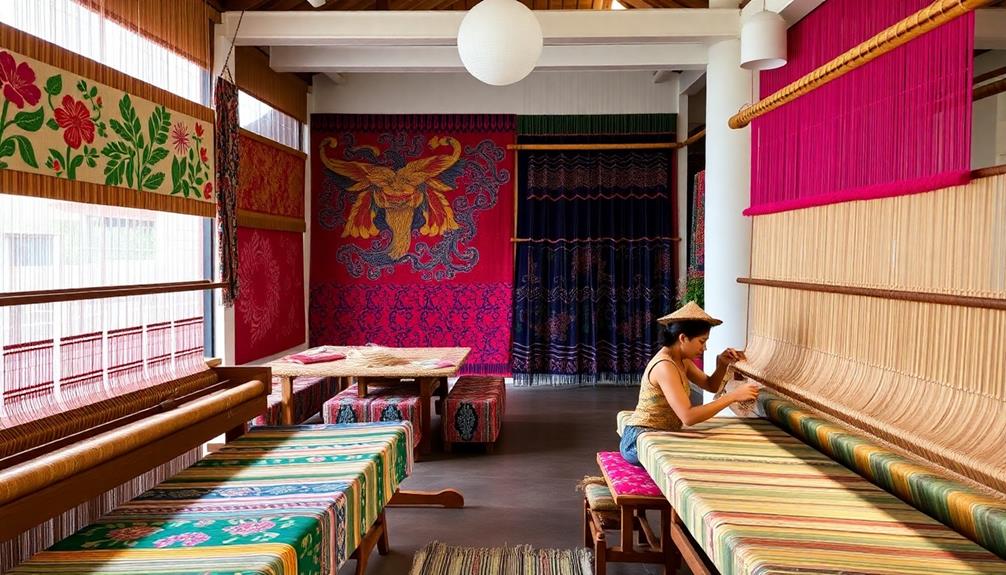
When you explore Indonesian textiles, you'll find that traditional weaving techniques like Batik and Tenun Lurik not only showcase intricate craftsmanship but also tell rich cultural stories.
These textiles often reflect the essence of Balinese design characteristics, blending vibrant patterns with natural materials to create a unique aesthetic.
As modern designers adapt these methods, they blend age-old artistry with contemporary aesthetics, enhancing the significance of textiles in interior spaces.
This fusion highlights how weaving remains an essential part of Indonesia's cultural identity and artistic expression.
Traditional Weaving Techniques
While exploring the rich tapestry of Indonesian culture, you'll discover that traditional weaving techniques like Batik and Tenun Lurik aren't just crafts but essential expressions of heritage and artistry.
These methods showcase intricate craftsmanship that has been meticulously passed down through generations, much like the traditional Indonesian housing styles which reflect regional identities and cultural significance.
Here are some key aspects of these traditional techniques:
- Batik: This process involves applying hot wax through a Canting or copper block stamp, followed by multi-stage dyeing, resulting in complex designs that tell stories.
- Tenun Lurik: Handwoven stripes require precision, focusing on color harmonization, creating patterns that reflect cultural narratives.
- Natural Dyeing: Artisans utilize locally sourced materials, like Morinda citrifolia for red and indigo for blue, ensuring the textiles maintain a connection to their environment.
- Spiritual Significance: Weaving practices, particularly among the Iban and Maloh communities in Borneo, often embody spiritual meanings and cultural values, making each piece a narrative of the community.
Additionally, these textiles can enhance modern Indonesian homes, blending tradition with contemporary design, as seen in the growing trend of sustainable urban development practices.
Modern Design Adaptations
Embracing the rich heritage of Indonesian textiles, modern design adaptations breathe new life into traditional weaving techniques, making them relevant for today's interior spaces.
Designers are increasingly incorporating intricate patterns and vibrant colors from textiles like Batik, Tenun Lurik, and Pua, creating eco-friendly textiles that stand out in contemporary decor.
Indonesian wedding decor ideas often celebrate these textiles, showcasing their versatility and beauty. By using natural dyes and sustainable materials, artisans guarantee that these adaptations align with the growing market for environmentally conscious home furnishings.
Contemporary designers often collaborate with traditional weavers, merging classic motifs with innovative designs that appeal to both local and international audiences.
This partnership not only preserves traditional craftsmanship but also adds cultural depth to modern interiors. The revival of interest in artisanal crafts has sparked a renewed appreciation for these textiles, emphasizing their significance in contemporary settings.
As you explore modern design adaptations, you'll discover how these vibrant pieces can transform your space, offering a unique blend of heritage and modernity.
With each textile telling its own story, you can celebrate the artistry and cultural richness of Indonesia while enhancing your home's aesthetic appeal.
Cultural Significance in Interiors
Indonesian textiles aren't just decorative elements; they embody a rich tapestry of cultural significance deeply woven into the fabric of daily life. Each piece, from Batik to Tenun Lurik, carries meanings that reflect the spiritual heritage of its community.
The intricate designs and meticulous craftsmanship involved in creating these textiles tell stories of ancestry and identity. Furthermore, these textiles can complement modern interior styles, enhancing the overall aesthetic with a touch of tropical contemporary design.
Here are some key aspects of their cultural significance in interiors:
- Ceremonial Use: Textiles often play a role in traditional ceremonies, adding depth to their meaning.
- Spiritual Connections: Many designs are inspired by sacred objects, reinforcing cultural beliefs.
- Ancestral Stories: Each textile piece represents a continuation of the community's history and values.
- Artistic Techniques: The multi-stage dyeing process in Batik creates complex designs that enhance modern aesthetics.
Incorporating these textiles into your interior design not only enriches the visual appeal but also showcases the artistry and craftsmanship that honors Indonesia's cultural narratives.
Integrating Textiles in Modern Interiors

Incorporating textiles like Batik and Tenun Lurik into your home can truly elevate your interior design. These rich, vibrant patterns not only add visual interest but also serve as a great art form that embodies cultural richness. You can use these textiles in versatile ways—think decorative pillows, wall hangings, or even curtains. Each piece becomes a focal point, seamlessly blending heritage with contemporary style.
As you integrate these textiles, you're also embracing sustainable and eco-friendly practices. Many Indonesian artisans use traditional methods that honor the environment, making these textiles a conscious choice for your decor. By choosing these beautiful fabrics, you contribute to the resurgence of artisanal crafts and support local communities.
Moreover, textiles from Indonesia can become a conversation starter, connecting your space to its cultural origins and stories. Guests will appreciate the unique aesthetic and the narrative behind each piece.
Preserving Textile Heritage

Preserving the heritage of Indonesian textiles is essential for keeping alive the cultural identity and historical narratives woven into traditional fabrics like Batik and Pua.
By understanding the significance of these textiles, you can appreciate the craftsmanship that artisans have honed over generations.
Here are four key ways to support preservation efforts:
- Educational Programs: Participate in or promote initiatives that teach the cultural significance and techniques of Batik and other traditional textiles.
- Collaborate with Artisans: Work alongside local artisans to sustain traditional weaving practices and guarantee that their skills are passed down.
- Support Innovation: Embrace modern fashion trends that incorporate traditional textiles, allowing for innovation while respecting their heritage.
- Raise Awareness: Advocate for the cultural relevance of ceremonial textiles like Pua sungkit, especially as their rarity increases due to changing societal practices.
Frequently Asked Questions
What Is the Indonesian Textile Technique?
Indonesian textile techniques include Batik and Tenun. Batik combines wax and dye for intricate designs, while Tenun emphasizes precise weaving. Each method reflects cultural heritage, showcasing vibrant patterns and craftsmanship that captivates and inspires you.
What Are the Traditional Indonesian Textiles?
You'd think traditional Indonesian textiles are merely fabric, but they're vibrant stories woven with history. Batik, Songket, Pua, Tenun Lurik, and Geringsing offer cultural depth, each thread reflecting a rich heritage waiting to be explored.
What Are the Traditional Uses of Textiles of Bali?
In Bali, you'll find textiles used in rituals, ceremonies, and daily life. They wrap sacred objects, adorn ceremonial garments, and reflect spirituality, showcasing respect for traditions while promoting harmony between humanity, nature, and the divine.
What Are the Fabric and Fabric Design of Indonesia?
Did you know that over 300 distinct traditional fabrics exist in Indonesia? You'll find Batik's intricate patterns, Tenun's woven artistry, and the luxurious Songket, each telling stories of culture, heritage, and craftsmanship through their designs.
Conclusion
Incorporating Indonesian textiles into your home is like adding a vibrant brushstroke to a masterpiece; it infuses life and character into your space. These rich fabrics, from batik to pua, not only showcase exquisite craftsmanship but also tell stories of culture and tradition. By embracing these textiles, you're not just decorating—you're preserving a heritage that deserves to be celebrated. So go ahead, weave a touch of Indonesia's magic into your modern interior and let your space tell its own tale.
- About the Author
- Latest Posts
Introducing Ron, the home decor aficionado at ByRetreat, whose passion for creating beautiful and inviting spaces is at the heart of his work. With his deep knowledge of home decor and his innate sense of style, Ron brings a wealth of expertise and a keen eye for detail to the ByRetreat team.
Ron’s love for home decor goes beyond aesthetics; he understands that our surroundings play a significant role in our overall well-being and productivity. With this in mind, Ron is dedicated to transforming remote workspaces into havens of comfort, functionality, and beauty.
Decor
The Future of Home Decor: Tech-Integrated Furniture and Accessories
Modernize your living space with tech-integrated furniture and accessories that promise to revolutionize your home—discover what awaits in this exciting trend!
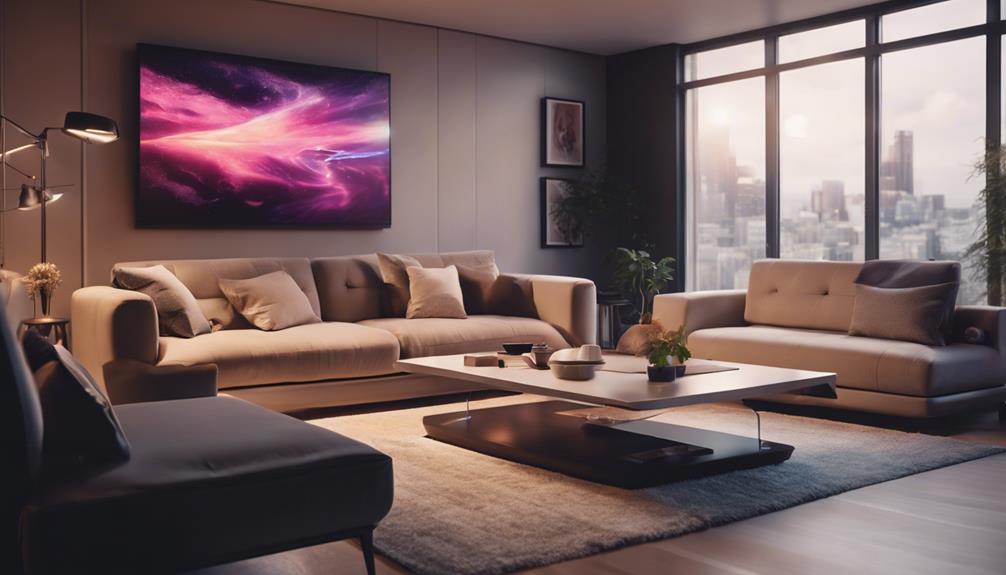
The future of home decor is all about tech-integrated furniture and accessories that enhance your living experience. You're looking at smart designs like adjustable desks, multifunctional coffee tables, and mattresses that monitor your sleep. These innovations not only make your space more convenient but also promote wellness and sustainability. Imagine controlling your lights and temperature with just your voice, all while enjoying a clutter-free environment thanks to wireless charging solutions. As you explore this exciting trend, you'll discover how these advancements can transform your home into a smarter, more stylish refuge.
Key Takeaways
- Tech-integrated furniture combines functionality and style, featuring wireless charging, adjustable ergonomics, and multifunctional designs for modern living spaces.
- Smart systems enable voice command control of home environments, enhancing convenience and automating daily tasks for improved efficiency.
- Health and wellness-focused designs, like smart mattresses and posture sensor chairs, promote better sleep and ergonomics for a healthier lifestyle.
- Sustainable materials and energy-efficient options support eco-friendly living, aligning decor choices with sustainability goals.
Design Meets Technology
In today's world, furniture design seamlessly blends with technology, making your living spaces more functional and stylish than ever.
You'll find smart furniture options that cater to your needs, from wireless charging stations to adjustable ergonomics. These innovations allow you to eliminate clutter while personalizing your comfort. Imagine a sofa that adjusts to your preferred position at the touch of a button or a desk that raises and lowers to encourage better posture.
Additionally, incorporating captivating decor ideas can enhance the overall aesthetic of your tech-integrated spaces, creating a warm and inviting atmosphere.
As technology continues to evolve, designers are focusing on multifunctional pieces that maximize space efficiency, particularly in urban areas. Features like built-in storage and USB charging ports are becoming standard, helping you make the most of limited space. The aesthetics of your home don't have to suffer, either; the fusion of design and technology enhances overall beauty while redefining user experiences.
Voice command interactions are becoming commonplace, allowing you to effortlessly adjust settings without lifting a finger. With these advancements, your home can transform into an intuitive and interconnected environment that caters to your lifestyle, making everyday tasks easier and more enjoyable.
Embrace this trend, and watch your living spaces become a harmonious blend of style and functionality.
Innovative Smart Furniture

Innovative smart furniture redefines your living space by seamlessly merging technology and design to enhance both comfort and functionality. With features like wireless charging stations and height-adjustable desks, you can cater to your individual comfort needs while boosting productivity in your home environment.
Multifunctional designs, such as transformable coffee tables and smart sofas with built-in storage, maximize space utilization, making them perfect for compact living situations, especially in urban areas. Imagine having versatile pieces that adapt to your lifestyle, keeping your space organized and stylish.
Smart mattresses equipped with sleep monitoring technology provide valuable insights for improved rest, while adjustable beds with massage functions promote relaxation and wellness at home. Plus, energy-efficient options like solar-powered charging stations align with eco-friendly living practices, helping you reduce your carbon footprint.
The integration of voice command systems allows you to connect with smart home devices effortlessly. You can control lighting, temperature, and entertainment through simple voice interactions, making your daily routines more intuitive.
Embracing tech-integrated furniture not only transforms your space but also enhances your overall living experience.
Benefits of Connectivity

Smart furniture connects seamlessly with your existing devices, making it easier to automate and control your home environment. By integrating with other smart technologies, you can manage lighting, temperature, and entertainment systems, enhancing efficiency throughout your living space. Imagine adjusting your home's ambiance with just a voice command or a tap on your smartphone.
With features like wireless charging stations and app-controlled settings, smart furniture reduces clutter and streamlines your daily tasks. This convenience aligns perfectly with modern lifestyles, where every second counts. Syncing with voice assistants like Amazon Alexa or Google Assistant allows you to enjoy hands-free control, letting you focus on what matters most.
Moreover, many energy-efficient smart furniture options contribute to your sustainability goals. They optimize power usage, helping you lower utility costs while maintaining functionality. Plus, the incorporation of mood-setting lighting and temperature regulation creates adaptable spaces that respond to your preferences, enhancing overall comfort.
In short, the connectivity of smart furniture not only simplifies your life but also makes your home more efficient and enjoyable. Embracing these innovations can transform your living environment into a seamless blend of comfort and technology.
Enhancing User Experience

Enhancing user experience in home decor means integrating features like wireless charging and adjustable ergonomics for personalized comfort, all while eliminating cable clutter. Smart furniture is revolutionizing how you interact with your living space, making it more functional and enjoyable. Imagine a world where your furniture caters to your needs, allowing you to control lighting and temperature with just your voice, thanks to integrations with Amazon Alexa or Google Assistant.
Here's a glimpse of the benefits:
| Feature | Benefit | Emotional Impact |
|---|---|---|
| Wireless Charging | No more tangled cords | Stress relief from clutter |
| Adjustable Ergonomics | Customized comfort | Enhanced well-being |
| Smart Mattresses | Improved sleep quality | Better health and wellness |
| Voice Command Control | Simplified daily routines | Increased convenience |
| Interactive Designs | Immersive entertainment experiences | Joyful moments with family |
With these advancements, you're not just beautifying your home; you're enhancing user experience and prioritizing comfort and health. Welcome to a new era of living, where your home truly works for you!
Transforming Living Spaces
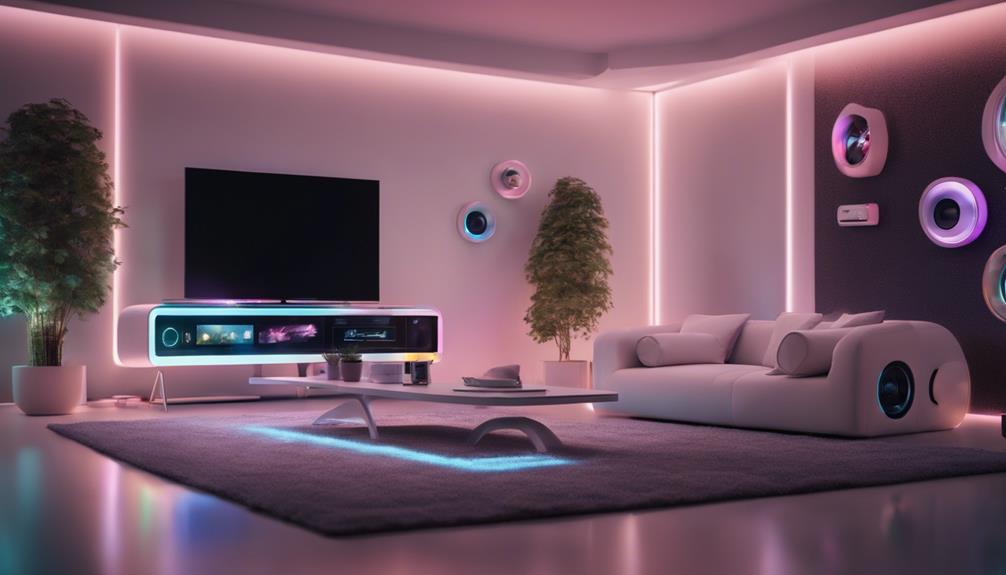
Tech-integrated furniture is redefining how you transform living spaces, making them more functional and tailored to your lifestyle.
Imagine a home where your furniture not only complements the decor but also enhances your daily activities. With features like wireless charging stations and adjustable ergonomics, tech-integrated furniture caters to your individual needs. Additionally, incorporating various materials available allows for customization that meets both aesthetic and functional requirements.
You can maximize space in urban settings by choosing multifunctional pieces such as transformable coffee tables and smart sofas with built-in storage. These innovative solutions efficiently utilize every inch of your living space, perfect for compact living situations.
Moreover, wellness-focused smart furniture, including adjustable beds and smart mattresses, promotes healthier lifestyles by monitoring your sleep patterns, making self-care a priority at home.
As technology advances, you'll also find sustainable options like biodegradable plastics and 3D printed furniture, aligning your decor choices with eco-friendly living.
Seamless Automation Features
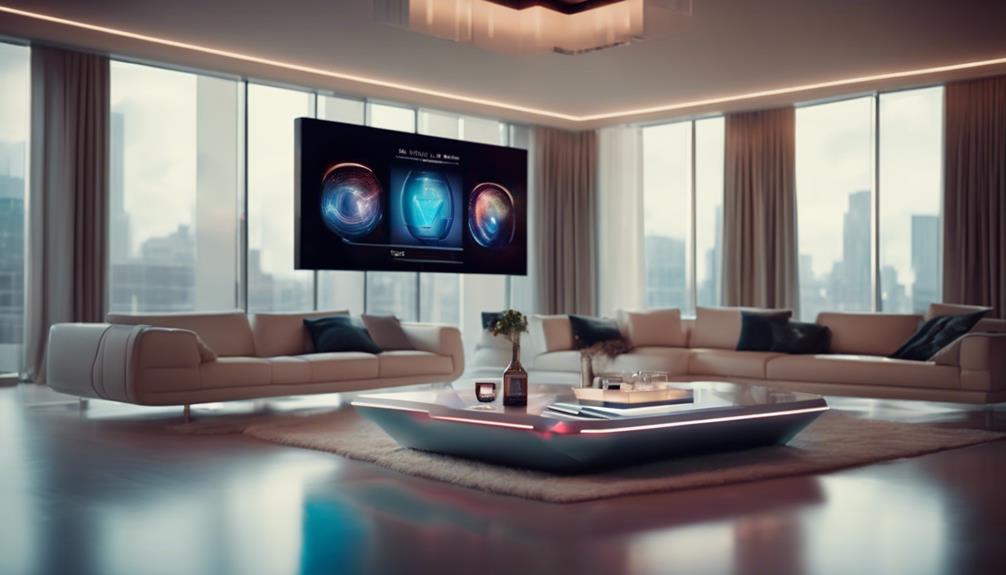
With seamless automation features, you can easily control your home environment using voice commands.
Imagine adjusting your lighting and connecting with other smart devices through simple prompts.
This integration not only adds convenience but also transforms how you interact with your living space.
Voice Command Integration
Voice command integration transforms how you interact with your home, allowing you to effortlessly control lighting, temperature, and more through simple voice commands. With smart furniture becoming increasingly popular, you can now adjust settings like height or mood lighting just by speaking.
Here's a quick overview of the benefits:
| Features | Benefits |
|---|---|
| Voice Commands | Control multiple devices hands-free |
| Smart Furniture | Personalized comfort adjustments |
| Clutter-Free Environment | Minimal need for physical controls |
Over 70% of consumers prefer homes equipped with voice-controlled devices, showcasing the demand for seamless automation in living spaces. This technology not only makes daily tasks easier but also contributes to a sleek and modern aesthetic by minimizing clutter. Imagine adjusting your recliner or dimming lights without ever needing to reach for a switch! The integration of voice commands in smart furniture creates a more intuitive living experience, enhancing your comfort and efficiency. By embracing these advancements, you're stepping into the future of home decor, where convenience and style go hand in hand.
Automated Lighting Solutions
Automated lighting solutions revolutionize your home environment by seamlessly integrating with smart systems, allowing you to control lighting through simple commands.
With platforms like Amazon Alexa and Google Assistant, you can adjust your lights using just your voice, making it easier to create the perfect ambiance for any occasion.
Imagine waking up to a gentle sunrise effect, mimicking natural light patterns that enhance your mood and promote better sleep cycles.
These systems can also be programmed to respond to occupancy, ensuring energy efficiency by turning off lights in unoccupied spaces. This not only saves you money on your energy bills but also helps reduce your carbon footprint.
Moreover, smart lighting features let you customize settings for different activities, from movie nights to cozy dinners. You can adjust the brightness and color temperature to match your desired atmosphere effortlessly.
Many automated lighting solutions also support remote control via mobile apps, giving you the convenience to manage your home's lighting from anywhere.
Embracing these innovations means you'll enjoy a more functional, stylish, and energy-efficient living space.
Smart Home Connectivity
Smart home connectivity transforms your living space by effortlessly automating daily tasks and integrating furniture with devices like smart lighting and thermostats. This technology makes your home more convenient and efficient, allowing you to enjoy a seamless living environment.
With smart furniture solutions, you can experience features like:
- Voice control: Adjust settings hands-free using Alexa or Google Assistant.
- Automated lighting: Enjoy smart lights that mimic sunrise, improving your wake-up routine.
- Streamlined control: Sync furniture with existing devices to manage lighting, temperature, and entertainment from one place.
- Energy optimization: Smart furniture can help reduce energy consumption, with options like solar-powered charging stations.
Multifunctional and Adaptable Designs

When you think about maximizing your living space, multifunctional furniture becomes essential.
Transformable options like coffee tables that shift into workspaces or sofas with hidden storage cater to your needs while keeping your home organized.
With versatile functionality features, you can adapt your furniture to fit various activities seamlessly, making your space more efficient and enjoyable.
Space-Saving Solutions
Maximizing space in urban living requires innovative furniture solutions that adapt to your changing needs. Today's space-saving solutions consist of multifunctional and adaptable designs that make the most of every square foot in your home.
With the right furniture, you can create a more efficient living environment without sacrificing comfort or style.
Here are some key features to look for in space-saving furniture:
- Smart sofas with built-in storage and USB charging ports
- Transformable coffee tables that double as dining tables or work desks
- Height-adjustable desks for personalized ergonomic comfort
- Motorized recliners that adapt to your relaxation needs
These innovative designs not only enhance functionality but also reflect a growing consumer demand for versatile furniture.
By choosing adaptable pieces, you can transform your space as your lifestyle changes, promoting a more efficient use of living areas.
Embracing multifunctional furniture is essential for anyone looking to maximize their space and improve their overall living experience.
Transformable Furniture Options
Transformable furniture options are revolutionizing urban living by offering multifunctional designs that adapt to your ever-changing needs.
These innovative pieces, like sofas with built-in storage and USB charging ports, maximize space efficiency, making them ideal for compact homes. Imagine a coffee table that seamlessly converts into a dining table or work desk; it allows you to optimize your living space for various activities without sacrificing style.
Height-adjustable desks and motorized recliners exemplify the trend toward customizable ergonomics, catering to your comfort and productivity when working from home. You can easily adjust these pieces to suit your preferences, ensuring a more enjoyable experience.
Additionally, smart furniture solutions with integrated screens and speakers enhance your living area's functionality, offering seamless connectivity for entertainment and work. This tech integration not only saves space but also enriches your environment.
The rise of transformable furniture is driven by the growing demand for space-saving solutions, as urban living spaces continue to shrink. By choosing adaptable designs, you can create a versatile home that meets your needs and reflects your lifestyle.
Embrace the future of home decor with transformable furniture that truly works for you.
Versatile Functionality Features
Multifunctional furniture pieces fit seamlessly into your home, adapting to your lifestyle and offering versatile solutions for everyday tasks. These tech-integrated furniture options maximize space efficiency, especially in compact living areas. Here's how they enhance your home:
- Transformable coffee tables that double as dining tables or work desks
- Smart sofas with built-in storage and USB charging ports
- Height-adjustable desks for personalized comfort settings
- Motorized recliners that adjust with simple commands
With these versatile functionality features, you can easily shift between different activities without cluttering your space.
Whether you're working from home, hosting guests, or just relaxing, multifunctional designs provide the adaptability you need.
The integration of smart features not only boosts usability but also keeps your decor stylish.
Embracing these innovative solutions means your furniture can evolve with you, meeting your needs today and tomorrow.
Health and Wellness Integration

Many modern homes are now featuring tech-integrated furniture that prioritizes health and wellness, making it easier for you to enhance your well-being while enjoying stylish decor.
Wellness-focused smart furniture is revolutionizing how you interact with your living space. For instance, smart mattresses can monitor your sleep patterns and provide insights to help improve your sleep quality, contributing to your overall wellness at home.
Adjustable beds with massage functions cater to your individual health needs, promoting relaxation and comfort. You can also invest in chairs equipped with posture sensors, which encourage better ergonomics and reduce the risk of musculoskeletal issues.
The integration of health features in home decor emphasizes self-care, with products designed to support your mental and physical health through technology. Companies like StoreLuxy are leading the charge, offering holistic wellness solutions that incorporate smart functionalities within furniture design.
Sustainable Decor Practices

Sustainable decor practices are reshaping the way you think about your living space, emphasizing eco-friendly materials and innovative designs that minimize environmental impact. By incorporating sustainable materials into your home, you're not only enhancing aesthetics but also contributing to a healthier planet.
Here's how you can embrace these practices:
- Use eco-friendly materials: Opt for biodegradable plastics and sustainably sourced woods in your furniture.
- Explore recycled components: Choose decor items made from recycled materials for unique and one-of-a-kind pieces.
- Utilize 3D printing: This technology allows for precise manufacturing, reducing waste and creating customized designs tailored to your space.
- Support circular economy brands: Look for companies that promote reusability and recycling of furniture at the end of its lifecycle.
Future Trends in Home Decor
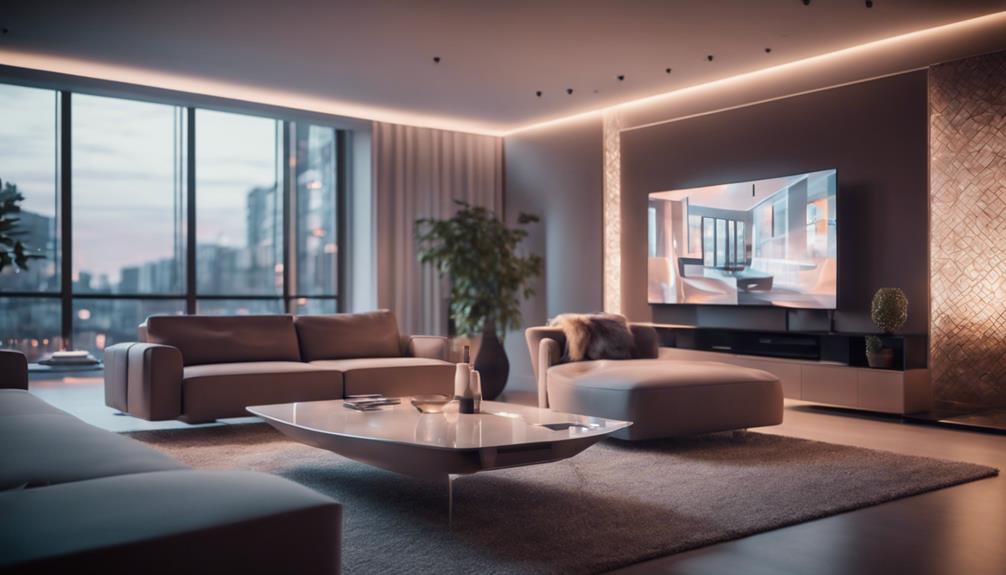
As you look ahead, smart furniture innovations are set to reshape your living space with technology that enhances functionality and convenience.
At the same time, sustainability in design is gaining traction, pushing you to evaluate eco-friendly materials and practices in your decor choices.
Together, these trends promise to create a more connected and environmentally conscious home environment for you to enjoy.
Smart Furniture Innovations
Smart furniture innovations are revolutionizing home decor by seamlessly blending technology with everyday living, making your space more functional and efficient.
These advancements cater to your modern lifestyle, offering solutions that maximize comfort and convenience.
Here are some exciting features to look out for:
- Wireless charging: No more tangled cords—just place your devices on surfaces designed to charge them effortlessly.
- Adjustable ergonomics: Furniture that adapts to your body guarantees comfort during long hours of work or relaxation.
- Multifunctional designs: Transformable coffee tables and smart sofas with hidden storage can optimize your living space, especially in urban environments.
- Health-focused technology: Smart mattresses and adjustable beds track your sleep patterns, promoting better rest and overall wellness.
Sustainability in Design
Eco-friendly design is taking center stage in home decor, reflecting a growing commitment to reducing environmental impact while enhancing your living space. More than ever, designers are prioritizing eco-friendly materials, like biodegradable plastics, to minimize waste and pollution in decor manufacturing. This shift not only promotes sustainability but also offers you stylish options for your home.
Sustainable sourcing of materials is essential in this movement. Many businesses are now adopting transparency in their supply chains, ensuring that the materials used are responsibly sourced and ethically produced. This means you can feel good about the choices you make for your home.
Additionally, the rise of 3D printing technology allows for customized furniture solutions while considerably reducing waste. Innovations in recycling processes enable the reuse of materials, creating sustainable decor options that align with your eco-conscious values.
Lastly, wellness-focused designs are gaining traction, emphasizing a holistic approach to sustainable living. By integrating these principles into your home decor, you'll not only create a beautiful space but also contribute to a healthier planet. Embrace these trends and make your home a beacon of sustainability.
Frequently Asked Questions
Why Smart Furniture Is the Future?
Smart furniture's the future because it combines convenience, comfort, and sustainability. You'll enjoy interactive designs, energy efficiency, and seamless home automation, making your living space more functional and tailored to your lifestyle. Embrace this innovation!
Conclusion
As you step into the future of home decor, imagine your living space evolving like a chameleon, adapting to your needs with every flick of a switch.
Tech-integrated furniture isn't just a trend; it's a bridge connecting comfort and innovation.
With multifunctional designs and a focus on sustainability, your home transforms into a sanctuary of health and convenience.
Embrace this blend of style and smart technology, and watch your environment flourish like a garden in full bloom.
- About the Author
- Latest Posts
Introducing Ron, the home decor aficionado at ByRetreat, whose passion for creating beautiful and inviting spaces is at the heart of his work. With his deep knowledge of home decor and his innate sense of style, Ron brings a wealth of expertise and a keen eye for detail to the ByRetreat team.
Ron’s love for home decor goes beyond aesthetics; he understands that our surroundings play a significant role in our overall well-being and productivity. With this in mind, Ron is dedicated to transforming remote workspaces into havens of comfort, functionality, and beauty.
-

 Retreat7 days ago
Retreat7 days agoDIY Aromatherapy Diffusers for a Spa-Like Atmosphere at Home
-

 Retreat2 weeks ago
Retreat2 weeks agoThe Profitability of Retreat Centers: A Financial Analysis
-

 Retreat1 week ago
Retreat1 week agoUnusual DIY Projects: Designing a Space Probe in Bitlife
-

 Retreat2 weeks ago
Retreat2 weeks agoComprehensive Review: Are Home Decorators Ceiling Fans Worth the Investment?
-

 Retreat2 weeks ago
Retreat2 weeks agoIs Opening a Home Decor Store Profitable in 2024?
-

 Retreat1 week ago
Retreat1 week agoHow to Create a Zen Garden for Your Retreat Center
-

 Retreat2 weeks ago
Retreat2 weeks agoStep-By-Step Tutorial: Reupholstering a Chair With Buttons
-

 Retreat5 days ago
Retreat5 days agoThe Psychology of Color in Retreat Center Design











